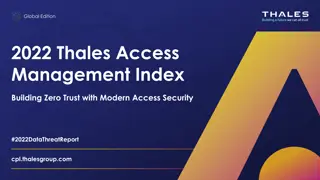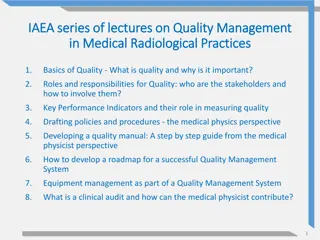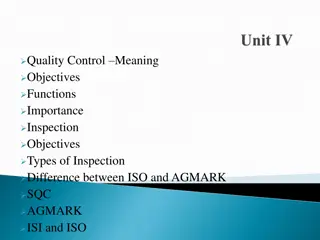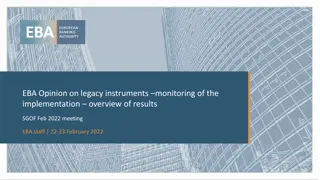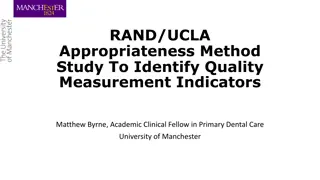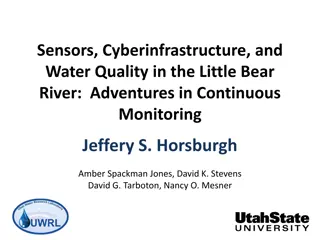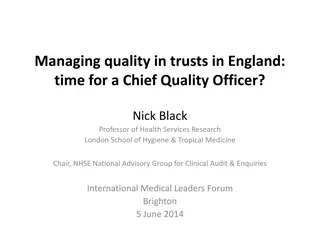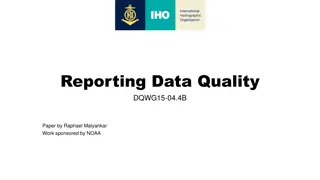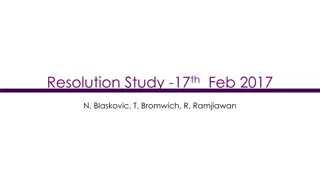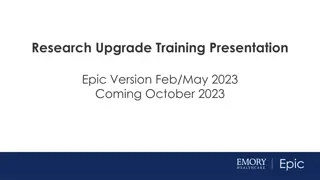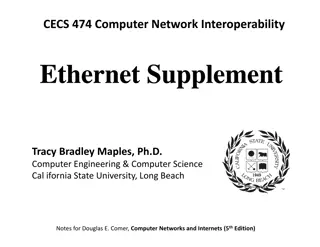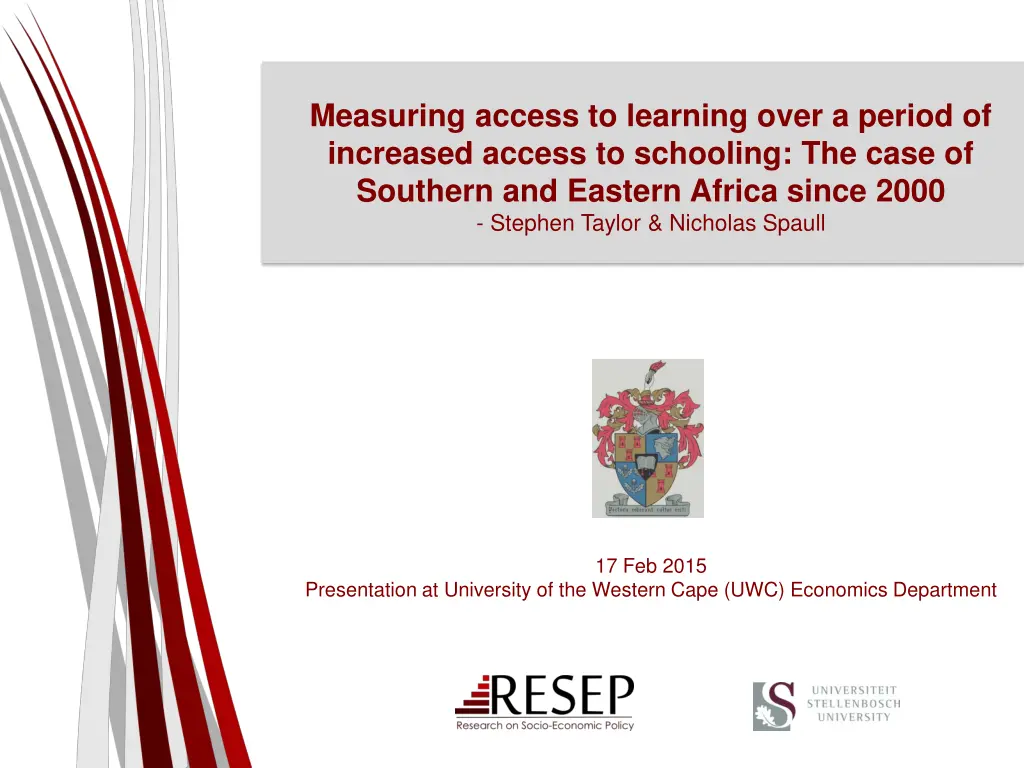
Access and Quality in Education: Understanding the Impact on Economic Development
Explore the evolution of economic analysis in education from the 1960s to the present, focusing on the importance of cognitive skills in shaping economic outcomes. Learn how measuring access to learning alongside quality is essential for meaningful policy discussions and effective human capital development.
Uploaded on | 2 Views
Download Presentation

Please find below an Image/Link to download the presentation.
The content on the website is provided AS IS for your information and personal use only. It may not be sold, licensed, or shared on other websites without obtaining consent from the author. If you encounter any issues during the download, it is possible that the publisher has removed the file from their server.
You are allowed to download the files provided on this website for personal or commercial use, subject to the condition that they are used lawfully. All files are the property of their respective owners.
The content on the website is provided AS IS for your information and personal use only. It may not be sold, licensed, or shared on other websites without obtaining consent from the author.
E N D
Presentation Transcript
Measuring access to learning over a period of increased access to schooling: The case of Southern and Eastern Africa since 2000 - Stephen Taylor & Nicholas Spaull 17 Feb 2015 Presentation at University of the Western Cape (UWC) Economics Department
Introduction & background Since its inception, the discipline of economics has always had a keen interest in education and skills Essentially three periods in the education-in-economics literature Period 1: up to 1960 economists discuss importance of education and skills but not within a single unified theory. The improved dexterity of a workman may be considered in the same light as a machine or instrument of trade which facilitates and abridges labour, and which, though it costs a certain expense, repays that expense with a profit (Smith, 1776, p. 166). Capital consists in a great part of knowledge and organisation Knowledge is our most powerful engine of production; it enables us to subdue Nature and force her to satisfy our wants (Marshall, 1890, p. 115). Period 2: Establishment of Human Capital literature, primarily by Mincer (1958), Schultz (1961) and particularly Becker (1962) 1960- 2001 where education was included in economic analyses but proxied using enrolment rates and/or grade attainment (i.e. quantity) Not unacknowledged but unsolved Blaug speaks about the unresolved problem in rate of return studies and explains that students choose, not just schooling, but schooling of a certain type and quality, and few rate-of-return calculations have succeeded in successfully standardizing the calculated yields for quality of educational institutions (Blaug, 1976, p. 841). Period 3: 2000+ Hanushek & Kimko (2000), Hanushek & Woessman (2008) [later others] incorporated education quality into economic analyses When trying to explain economic growth using a model of income and years of schooling, the share of the variation in economic growth explained by the model jumps from 0,25 to 0,73 when cognitive skills are added to the model.
Access & Quality It is both conventional and convenient in policy discussions to concentrate on such things as years of school attainment or enrolment rates at schools. These things are readily observed and measured. They appear in administrative data, and they are published on a consistent basis in virtually all countries of the world. misleading in the policy debates. schooling that does not improve cognitive skills has limited impact on aggregate economic outcomes and on economic development We provide ignoring differences in cognitive skills significantly distorts the picture about the relationship between education and economic outcomes (Hanushek & Woessmann, 2008, p. 608). And they are very strong evidence that
Access & Quality Defining the scope of the problem of lack of education must begin with the objectives of education which is to equip people with the range of competencies necessary to lead productive and fulfilling lives fully integrated into their societies and communities. Many of the international goals are framed exclusively as enrolments or universal completion. But getting and keeping children in school is merely a means to the more fundamental competencies and learning achievement (Pritchett, 2004, p. 1). targets for universal objectives of . creating
Access & Quality While nearly all countries education systems are expanding quantitatively nearly all are failing in their fundamental purpose .. A goal of school completion alone is an increasingly action focusing on the learning achievement of all children in a cohort a [Millennium Learning Goal] eliminates the false access/enrolment and quality of those in school : reaching an MLG depends on both (Filmer, Hasan, & Pritchett, 2006, p. 1). inadequate guide for dichotomy between
Access to what? Creating a composite indicator of educational access and educational quality for 11 African countries Aim Create a single composite indicator that combines educational quantity (enrolment & grade survival) with educational quality (educational outcomes) Identify what proportion of students never enroll, enroll but dropout before completing Gr6, complete Gr6 but remain illiterate/innumerate, complete Gr6 with basic skills, complete Gr6 with higher order skills All of the above for important subgroups of gender and wealth. Literature Large literature illustrating that in many developing countries children often learn little despite being enrolled in school (Filmer, 2006; Pritchett, 2013; Muralidharan & Zieleniak, 2013; Taylor et al, 2013) Pioneering work of Hanushek & Kimko/Woessman (2000/2008) shifted the focus from the quantity of educ (enrolment/attainment) to educ quality (outcomes)
Chapter 4: Access to what? Creating a composite indicator of educational access and educational quality for 11 African countries Method Access: Use Demographic and Health Survey (DHS) data for enrolment and grade survival rates (highest grade completed) We use 19-23 year olds because <5% of those 19yrs+ are currently enrolled in grades 1-6. Serious problems with using NERs, NARs, & Kaplan-Meier estimates Quality: Use SACMEQ Gr6 numeracy and literacy test results Combine the two by assuming that children who do not complete grade 6 are illiterate and innumerate (i.e. do not reach SACMEQ level 3) which provides the proportion of a cohort who complete grade 6 and acquire basic reading/mathematical skills. Termed access-to-literacy and access-to-numeracy (alternatives were efficacious enrolment , effective enrolment ) For national and gender-specific rates one can multiply DHS grade 6 completion rates with SACMEQ literacy rates to get access-to-literacy For SES sub-groups this is not possible due to differential grade 6 completion rates by SES group (40:40:20). I correct for this.
Chapter 4: Access to what? Creating a composite indicator of educational access and educational quality for 11 African countries Take Mozambique: Gr6 comp rate (DHS): Gr6 literacy rate (SACMEQ): 53% 79% Access-to-literacy rate: 42%
Access to what? Creating a composite indicator of educational access and educational quality for 11 African countries FIGURE 17: GAPS IN ACCESS-TO-LITERACY RATES BY GENDER, GENDER- WEALTH INTERACTION, AND WEALTH WITH 95% CONFIDENCE INTERVALS SES gaps in A2L are larger than gender gaps in all countries. Gender Differential (Male-Female) Gender-Wealth Differential (Poor40M-Poor40F) Wealth Differential (Rich20-Poor40) Poorer countries Boys > girls 80 60 Richer countries girls > boys Differential (percentage points) 40 20 Combining access and quality shows the true extent of differences between subgroups (eg Mozambique, Lesotho). 0 -20 -40 -60
FIGURE 19: ACCESS TO LITERACY RATES FOR MOZAMBICAN SUB- GROUPS (DHS 2011, SACMEQ 2007)
FIGURE 22: ACCESS TO LITERACY FOR LESOTHO 19-23 YEAR OLD SUB-GROUPS (DHS 2009, SACMEQ 2007)
Measuring access to learning over a period of increased access to schooling: The case of Southern and Eastern Africa 2000-2007 Aim Use the newly developed access-to-literacy measure to compare education system performance over time (2000-2007) Data Access: 2x DHS data sets per country circa 2003 and circa 2010 Quality: SACMEQ 2000 and SACMEQ 2007 Literature Strong perception of an access-quality trade-off (rarely tested empirically) In some African cases, the expansion of the primary system appears to have been accompanied by sharp declines in school quality, such that literacy and numeracy are no longer so readily delivered by the primary system. (Colclough, Kingdon and Patrinos 2009, p. 2). The impressive achievements made in improving access to school have to be balanced against issues of declining quality (Chimombo, 2009, p. 309). The rapid increases in school enrolment almost certainly have reduced school quality as schools became overcrowded and existing resources were strained (Glewwe et al. 2014, p. 391).
Findings 100 90 80 Percentage of children 70 FIGURE 24: ACCESS-TO-LITERACY RATES IN 2000 AND 2007 60 2000 50 2007 40 30 20 10 0 MAL ZAM MOZ UGA LES SOU TAN NAM KEN SWA 90 80 70 Percentage of children FIGURE 24: ACCESS-TO-NUMERACY RATES IN 2000 AND 2007 60 50 2000 40 2007 30 20 10 0 ZAM MAL MOZ UGA NAM LES SOU TAN KEN SWA
Access to literacy (Mozambique) Critical Reading Analytical reading A lower mode can decrease the average score but still be consistent with overall improvements if there are many more students at every level (as here) Inferential reading Interpretive reading SACMEQ 2007 Reading for meaning SACMEQ 2000 Basic Reading Emergent Reading Pre Reading 0 10000 20000 30000 40000 50000 60000 70000 Number of grade 6 enrolments
Access to quality & GPI Analysing gender inequalities in access to schooling OR learning outcomes (quality) understates the overall gender gap. For example in Mozambique Access (Gr6 completion): 63% for boys; 45% for girls (GPI=0.72) Quality (numerate): 70% for boys; 64% for girls (GPI=0.91) Access-to-numeracy: 44% for boys; 29% for girls (GPI=0.65) Congruent with the literature, for example Lewis and Lockheed (2006; 2007; 2008) who talk of a double disadvantage
Access to literacy, gender 1.8 1.6 1.4 FIGURE 29: GENDER PARITY INDEX WITH RESPECT TO ACCESS-TO-LITERACY IN 2000 AND 2007 1.2 1 GPI 2000 0.8 GPI 2007 0.6 0.4 0.2 0 MOZ ZAM MAL TAN UGA KEN SWA SOU NAM LES 1.6 1.4 FIGURE 30: GENDER PARITY INDEX WITH RESPECT TO ACCESS-TO-NUMERACY IN 2000 AND 2007 1.2 1 GPI 2000 0.8 GPI 2007 0.6 0.4 0.2 0 MOZ ZAM MAL TAN UGA KEN SWA NAM SOU LES
Access to higher order skills? 70% 35% 60% 30% Access to Higher Numeracy Access to Higher Literacy 50% 25% 40% 20% 2000 2007 30% 15% 20% 10% 10% 5% 0% 0% MAL ZAM MOZ LES UGA NAM SOU KEN TAN SWA MAL ZAM MOZ LES UGA NAM SOU SWA TAN KEN
Conclusions 1. Viewing country average test scores or enrolment rates in isolation is misleading, (esp RE trends) Education system performance should be reconceptualised as the amount of learning that takes place in the overall population of children (enrolled and non-enrolled) Expansion of access to primary schooling in these 10 countries contributed to improved access to literacy & numeracy Girls and the poor benefitted disproportionately Also accompanied by access to higher order literacy and numeracy Increased attainment of higher levels of schooling (Gr9 completion) Results robust to alternative measure of access (using augmented administrative data) rather than HH survey data The perception of an access-quality trade-off has less empirical support than was previously thought to be the case Important to develop these types of statistics for post-2015 MDG 2. 3. 4. 5.
Publications Spaull, N., and Taylor, S. (2015). Access to what? Creating a composite measure of educational quantity and educational quality for 11 African countries. Comparative Education Review. Vol. 58, No. 1. Taylor, S., and Spaull, N. (2015). Measuring access to learning over a period of increased access to schooling: The case of Southern and Eastern Africa since 2000. International Journal of Educational Development. (accepted)
Thank you Comments, suggestions & questions welcome
A trade-off between access & quality? The numbers of grade 6 children reaching each level of achievement: Mozambique reading Critical Reading Analytical reading Inferential reading Interpretive reading SACMEQ 3 Reading for meaning SACMEQ 2 Basic Reading Emergent Reading Pre Reading 0 10000 20000 30000 40000 50000 60000 70000 Number of grade 6 children (adjusted for population growth) Population growth (2000-2007) 20.6%.
A trade-off between access & quality? The numbers of grade 6 children reaching each level of achievement: Kenya reading Critical Reading Analytical reading Inferential reading Interpretive reading SACMEQ 3 Reading for meaning SACMEQ 2 Basic Reading Emergent Reading Pre Reading 0 50000 100000 150000 200000 Number of grade 6 children (adjusted for population growth) Population growth (2000-2007) 6.3%.
A trade-off between access & quality? The numbers of grade 6 children reaching each level of achievement: Tanzania maths Abstract Problem-solving Concrete Problem-solving Mathematically skilled Competent Numeracy SACMEQ 3 Beginning Numeracy SACMEQ 2 Basic Numeracy Emergent Numeracy Pre Numeracy 0 100000 200000 300000 Number of grade 6 children (adjusted for population growth) Population growth (2000-2007) 16.8%.
A trade-off between access & quality? The numbers of grade 6 children reaching each level of achievement: Uganda maths Abstract Problem-solving Concrete Problem-solving Mathematically skilled Competent Numeracy SACMEQ 3 Beginning Numeracy SACMEQ 2 Basic Numeracy Emergent Numeracy Pre Numeracy 0 50000 100000 150000 200000 Number of grade 6 children (adjusted for population growth) Population growth (2000-2007) 25.6%.
A trade-off between access & quality? The numbers of grade 6 children reaching each level of achievement: Malawi reading Critical Reading Analytical reading Inferential reading Interpretive reading SACMEQ 3 Reading for meaning SACMEQ 2 Basic Reading Emergent Reading Pre Reading 0 10000 20000 30000 40000 50000 60000 70000 Number of grade 6 children (adjusted for population growth) Population growth (2000-2007) 26.8%.
The TAULL story: Social composition: A trade-off between access & quality? 100% 90% 80% 70% Degree 60% Complete secondary Incomplete secondary 50% Incomplete primary 40% No education 30% No parent 20% 10% 0% MOZ 2MOZ 3 TAN 2 TAN 3 ZAM 2 ZAM 3 UGA 2 UGA 3 KEN 2 KEN 3
The TAULL story: Returns to parental education: A trade-off between access & quality? 700 650 600 Reading score 550 500 450 400 350 MOZ 2 MOZ 3 TAN 2 TAN 3 ZAM 2 ZAM 3 UGA 2 UGA 3 KEN 2 KEN 3 No education Incomplete primary Incomplete secondary Complete secondary Degree
Stretch on school resources Possibly consistent with production function literature: Teacher quality more NB than physical resources
Concluding discussion (Nics section) 1. We take the view that schooling that does not improve cognitive outcomes is only of limited value Therefore enrolment rates are incomplete and inaccurate Effectual enrolment rates are more informative 2. Our method of combining access (NAR) and quality (literacy/numeracy) is the most accurate, reliable and well-rounded measure of overall educational performance in SSA (as far as we are aware). The main innovation is the assumption that grade-6 aged students that are not attending school (dropout or non-enrolment) are functionally illiterate and functionally innumerate, allowing us to combine binary and continuous measures. Although it is uncomplicated it has not been done before for SSA Using DHS for cross-country comparisons of attendance rates is methodologically more sound than UNESCO s NER
Concluding discussion (Stephens section) 1. The case for a trade-off between access and quality (as measured by outcomes) has been overstated, at least for most countries included here. Countries can and have managed to increase both access to education, and the quality thereof. Resources are often stretched however, limited impact on performance able to do more with less per pupil. Only one country could not keep up with population growth: Malawi
Further research Does increased access to primary school lead to increase access to secondary and tertiary education? Somerset (2007) argues that the abolition of school fees in Kenya in 1974 led to a massive increase in grade 1 enrolments accompanied by a huge increase in drop-out thereafter. Our preliminary analysis suggests that the big expanders in SACMEQ also improved wrt survival to grade 9 and enrolment amongst 16 year-olds (using consecutive DHS s) However, bottlenecks can mean that expanded access can have the perverse impact of SES becoming a more important determinant of access to higher levels of education. (Lewin, 2007)
Persistence of benefits? Table X: Grade 9 survival rate amongst 10 -19 year olds Kenya Lesotho Tanzania Zambia Source: World Bank (2012) using the 2003 and 2008/9 DHS surveys for Kenya, the 2004 and 2009 DHS surveys for Lesotho, the 2004 and 2010 DHS surveys for Tanzania, the 2003 LCMS survey for Zambia and the 2007 DHS survey for Zambia. Baseline (2003/4) 0.54 0.56 0.21 0.64 Recent (2007/8/9/10) 0.76 0.66 0.43 0.71
Questions we have: How to link SACMEQ/skills distribution of the student population to skills distribution of the labour force? DHS enrolment rates are based on a questionnaire that says something like Were you at school for at least one day in the past year? very coarse measure of attendance Including SACMEQ scores in cross-country growth regressions ala H&W? useful? Interesting? Martin?
References Filmer, D. (2010). Educational Attainment and Enrollment around the World. The World Bank. econ.worldbank.org/projects/edattain: Development Research Group. Filmer, D., & Pritchett, T. (1999). The Effect of Household Wealth on Educational Attainment: Evidence from 35 Countries. Population and Development Review, 25(1), 85-120. Hanushek, E., & Woessmann, L. (2008). The Role of Cognitive Skills in Economic Development. Journal of Economic Literature, 46(3), 607-668. Hungi, N. (2010). What are the levels and trends in grade repetition? www.sacmeq.org: Southern and East African Consortium for Monitoring Educational Quality . Hungi, N., Makuwa, D., Ross, K., Saito, M., Dolata, S., van Capelle, F., et al. (2010). SACMEQ III Project Results: Pupil Achievement Levels in Reading and Mathematics. Paris: Southern and Eastern Africa Consortium for Monitoring Educational Quality. Lambin, R. (1995). "What can Planners Expect from International Quantitative Studies?" Reflections on Educational Achievement: Papers in Honour of T. Neville Postlethwaite. Waxmann Verlag. Lewin, K. (2007). Improving Access, Equity and Transitions in Education: Creating a Research Agenda. Co. Sussex: Consortium for research on Educational Access, Transitions and Equity (CREATE). Lewin, K. (2009). Access to education in sub-Saharan Africa: patterns, problems and possibilities. Comparative Education, 45(2). Pritchett, L. Towards a New Consensus for Addressing the Global Challenge of the Lack of Education. Copenhagen: Copenhagen Consensus, 2004. Ross, K., Saito, M., Dolata, S., Ikeda, M., Zuze, L., Murimba, S., et al. (2005). The Conduct of the SACMEQ II Project. In E. Onsomu, J. Nzomo, & C. Obiero, The SACMEQ II Project in Kenya: A Study of the Conditions of Schooling and the Quality of Education. Harare: SACMEQ. SACMEQ. (2010). SACMEQ III Project Results: Pupil Achievement Levels in Reading and Mathematics. Retrieved January 2011, from Southern and Eastern Africa Consortium for Monitoring Educational Quality: http://www.sacmeq.org/downloads/sacmeqIII/WD01_SACMEQ_III_Results_Pupil_Achievement.pdf Sen, A. (1999). Development as Freedom. Oxford: Oxford University Press UIS. (2009). Global Education Digest 2009: Comparing Education Statistics Across the World. Montreal: UNESCO Institute for Statistics. UNESCO. (2005). Education For All Global Monitoring Report 2005. Paris: UNESCO Publishing.
Proportion of Grade 6 aged population functionally numerate by wealth quintile Wealth differences Q1 Q2 Q3 Q4 Q5 100.0 90.0 80.0 SWA 70.0 KEN 60.0 TAN ZIM 50.0 40.0 SOU LES UGA 30.0 NAM MAL 20.0 ZAM 10.0 0.0 ZAM MAL NAM UGA LES SOU ZIM TAN KEN SWA 0 -5 -10 -15 -20 Q1 NAR correction Q2 NAR correction Q3 NAR correction Q4 NAR correction Q5 NAR correction
Functionally literate/numerate If a student reaches Level 3 for Reading and Mathematics, they are classified as being functionally literate and functionally literate. If not, they are classified as functionally illiterate and functionally innumerate. By this definition, a functionally illiterate learner cannot read a short and simple text and extract meaning, while a functionally innumerate learner cannot translate graphical information into fractions or interpret everyday units of measurement. An important innovation in the paper is our assumption that grade-6 aged students that are not attending school (due to dropout or non-enrolment) are functionally illiterate and functionally innumerate .this allows us to combine access (binary) and quality (continuous) variables. See Shabalala, 2005: p222 Basic reading (L3) Interprets meaning (by matching words and phrases, completing a sentence, or matching adjacent words) in a short and simple text by reading on or reading back. Basic numeracy (L3) Translates presented in a sentence, simple graph or table using one arithmetic operation in several repeated steps. Translates graphical information into fractions. Interprets place value in whole numbers up to thousands. Interprets common everyday measurement. verbal information simple units of
Correcting for differential access by quintile Correcting for dropout & non-enrolment Correcting for differential access by quintile (Tanzania) Functionally illiterate 21% of SACMEQ students come from quintile 5 100% 120 14.7 90% 30.1 100 80% 21 70% 80 18 60% Q5 20 50% 100 Q4 60 17 85.3 40% 21 Q3 69.9 18 40 30% Q2 19 20% 17 Q1 20 10% 19 16 0% 0 School age population NAR 14 year olds (median age in SACMEQ TAN) Of 14 year olds how many are literate from DHS As proportion 19% of SACMEQ students come from quintile 1 Net Attendance Rates NAR by quintile Quintile from DHS As proportion F-Lit (SACMEQ) Q1 79.9 20 16.0 18.7 94% Q2 83 20 16.6 19.4 95% Q3 89.2 20 17.8 20.9 97% Q4 85.7 20 17.1 20.1 99% Q5 89 20 17.8 20.9 98%
Sense-check Table 3: Grade survival rate [Data: World Bank survey data, Filmer (2010)] What about literate pre-Grade 6 dropout? Gr 1 91% 94% 95% 96% 96% 96% 97% 97% 99% 99% Gr 2 90% 92% 95% 96% 95% 96% 96% 97% 99% 99% Gr 3 89% 90% 93% 96% 94% 95% 95% 96% 98% 99% Gr 4 88% 86% 92% 95% 91% 94% 94% 94% 97% 99% Gr 5 85% 83% 89% 94% 88% 93% 92% 91% 96% 98% Gr 6 84% 79% 87% 93% 82% 91% 90% 89% 94% 98% Gr 7 82% 74% 84% 91% 74% 90% 85% 84% 91% 96% Gr 8 55% 69% 75% 88% 59% 86% 79% 72% 74% 94% Gr 9 55% 61% 71% 76% 56% 83% 74% 68% 69% 91% Tanzania Malawi Zambia Kenya Uganda Namibia Swaziland Lesotho Zimbabwe South Africa Perhaps children from SWA / TAN / KEN (where literacy rates in Gr6 are high) will be literate even though they dropout in Gr5? Unenrolled or dropout prior to end of Grade 1 Gr 2 Gr 3 Gr 4 Gr 5 Gr 6 % children who survive to grade 5 but not grade six is never > 5% 25% 20% 15% School system has still failed these children 10% 5% 0% South Africa Zimbabwe Lesotho Swaziland Namibia Uganda Kenya Zambia Malawi Tanzania
Sense-check Figure 7: Percentage point decrease in grade survival rate relative to previous grade Kenya Swaziland Uganda Lesotho Namibia Zambia Zimbabwe Tanzania Malawi South Africa 10% 9% 8% 7% 6% 5% 4% 3% 2% 1% 0% Unenrolled or dropout prior to end of Grade 1 Gr 2 Gr 3 Gr 4 Gr 5 Gr 6 Gr 7

